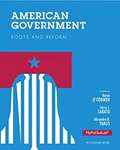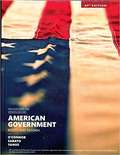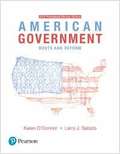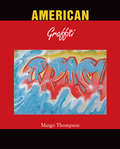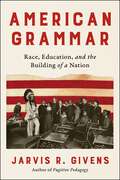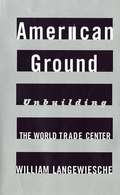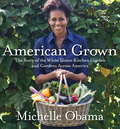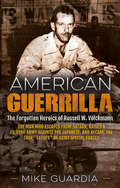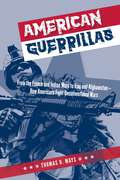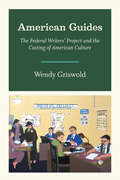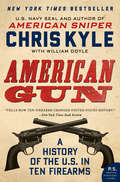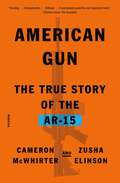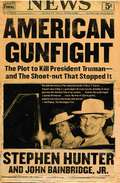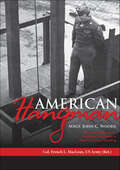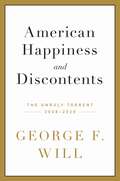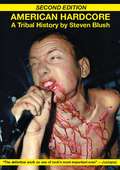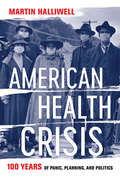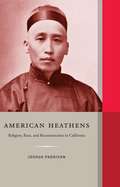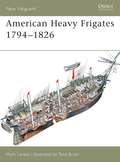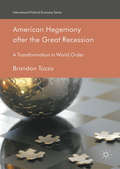- Table View
- List View
American Government: Power and Purpose (Thirteenth Edition)
by Benjamin Ginsberg Stephen Ansolabehere Theodore J. Lowi Kenneth A. ShepsleThe text that professors trust to get students thinking analytically about American government now includes new content on how race, gender, and group identity intersect with political behavior and institutions. And, leading scholars have contributed new "Analyzing the Evidence" features that engage students with the questions and methods that political students use themselves.
American Government: Roots And Reform,AP Edition
by Larry J. Sabato Karen J. O'Connor Alixandra B. YanusAmerican Government
American Government: Roots and Reform
by Karen O'Connor Larry J. Sabato Alixandra B. YanusAmerican Government: Roots and Reform Twelfth Edition, AP Edition, 2014 Elections and Updates Edition by Karen O'Connor, Larry J. Sabato, and Alixandra B. Yanus.
American Government: Roots and Reform
by Karen O'Connor Larry SabatoAmerican Government: Roots and Reform, 2016 Presidential Election Edition by Karen O'Connor and Larry Sabato.
American Graffiti
by Margo ThompsonDepuis le début des années 1970, les graffeurs décorent l'extérieur des rames de métro avec des tags toujours plus grands et toujours plus élaborés. Dans le schéma primitiviste, les graffeurs, en tant qu'artistes en marge, offraient de nouvelles perspectives à la société américaine. Ils tendaient un miroir à la culture hégémonique. Les références aux médias ou à des elements culturels que les artistes intégraient dans leurs créations revêtent aujourd'hui une importance toute particulière, parce qu'elles représentent un point de contact entre les cultures et ont rendu cette « sousculture » plus accessible à son nouveau public. Cette forme d'expression résolument rebelle est ici analysée par Margo Thompson qui met en relation l'art du graffiti avec l'art contemporain. Tout comme les graffeurs apportaient une voix à une classe ethnique sous-représentée, l'auteur, grâce à une thèse originale, tend à servir d'ambassadrice à cette forme d'art souvent méconnue.
American Grammar: Race, Education, and the Building of a Nation
by Jarvis R. GivensA new history of US education through the nineteenth century that rigorously accounts for Black, Native, and white experiences; a story that exposes the idea of American education as “the great equalizer” to not only be a lie, but also a myth that reproduces past harms. Education is the epicenter of every community in the United States. Indeed, few institutions are as pivotal in shaping our lives and values than public schools. Yet the nature of schooling has become highly politicized, placing its true colors on full display—a battleground where clashes over free speech and book bans abound, and where the suppression of knowledge about race, gender, and sexuality have taken center stage. Political forces are waging a war on academic freedom, raising serious questions. What gets taught, how, by whom, and who gets to decide? Yet, how might our perception of this reality shift when we recognize such battles as expressions of a relationship between race, power, and schooling as old as the country itself?Access and equity in public education have long been discussed and attempts to address the educational debts owed to historically oppressed groups have taken the form of modern innovations and promises of future improvement. Yet the past plays an equally significant role in structuring our present reality—and in the case of our education system, there is a dark, unexamined history that continues to influence how schools forge our world.Harvard University professor Jarvis R. Givens, an expert in the fields of American Educational History and African American Studies, draws on his own personal experiences and academic expertise to unveil how the political-economic exploitation of Black and Indigenous people played an essential role in building American education as an inequitable system premised on white possession and white benefit. In doing so, he clarifies that present conflicts are not merely culture wars, but indeed structural in nature. American Grammar is a revised origin story that exposes this legacy of racial domination in schooling, demonstrating how the educational experiences of Black, white, and Native Americans were never all-together separate experiences, but indeed relational, all part of an emergent national educational landscape. Givens reveals how profits from slavery and the seizure of native lands underwrote classrooms for white students; how funds from the US War Department developed native boarding schools; and how classroom lessons socialized students into an American identity grounded in antiblackness and anti-Nativeness, whereby the substance of schooling mirrored the very structure of US education. In unraveling this past, Givens provides more honest language for those working to imagine and build a truly more egalitarian future for all learners and communities, and especially those most vulnerable among us.
American Grand Strategy in the Mediterranean during World War II
by Andrew BuchananThis book offers a thorough reinterpretation of U. S. engagement with the Mediterranean during World War II. Andrew Buchanan argues that the United States was far from being a reluctant participant in a peripheral theater, and that Washington had a major grand-strategic interest in the region. By the end of the war the Mediterranean was essentially an American lake, and the United States had substantial political and economic interests extending from North Africa, via Italy and the Balkans, to the Middle East. This book examines the military, diplomatic, and economic processes by which this hegemonic position was assembled and consolidated. It discusses the changing character of the Anglo-American alliance, the establishment of post-war spheres of influence, the nature of presidential leadership, and the common interest of all the leaders of the Grand Alliance in blocking the development of potentially revolutionary movements emerging from the chaos of war, occupation, and economic breakdown.
American Ground: Unbuilding the World Trade Center
by William LangewiescheAn interesting study of the rescue effort after 9-11 and the attempt to clear away the debris, including the conflict between the fire and policemen.
American Ground: Unbuilding the World Trade Center
by William LangewiescheSelected as one of the best books of 2002 by The New York Times, San Francisco Chronicle, Boston Globe, Los Angeles Times, and Chicago Sun-TimesWithin days after September 11, 2001, William Langewiesche had secured unique, unrestricted, round-the-clock access to the World Trade Center site. American Ground is a tour of this intense, ephemeral world and those who improvised the recovery effort day by day, and in the process reinvented themselves, discovering unknown strengths and weaknesses. In all of its aspects--emotionalism, impulsiveness, opportunism, territoriality, resourcefulness, and fundamental, cacophonous democracy--Langewiesche reveals the unbuilding to be uniquely American and oddly inspiring, a portrait of resilience and ingenuity in the face of disaster.
American Grown: The Story of the White House Kitchen Garden and Gardens Across America
by Michelle ObamaIn April 2009, First Lady Michelle Obama planted a kitchen garden on the White House's South Lawn. As fresh vegetables, fruit, and herbs sprouted from the ground, this White House Kitchen Garden inspired a new conversation all across the country about the food we feed our families and the impact it has on the health and well-being of our children. Now, in her first-ever book, American Grown, Mrs. Obama invites you inside the White House Kitchen Garden and shares its inspiring story, from the first planting to the latest harvest. Hear about her worries as a novice gardener - would the new plants even grow? Learn about her struggles and her joys as lettuce, corn, tomatoes, collards and kale, sweet potatoes and rhubarb flourished in the freshly tilled soil. Get an unprecedented behind-the-scenes look at every season of the garden's growth, with striking original photographs that bring its story to life. Try the unique recipes created by White House chefs and made with ingredients just picked from the White House garden. And learn from the White House Garden team about how you can help plant your own backyard, school or community garden. Mrs. Obama's journey continues across the nation as she shares the stories of other gardens that have moved and inspired her: Houston office workers who make the sidewalk bloom; a New York City School that created a scented garden for the visually impaired; a North Carolina garden that devotes its entire harvest to those in need; and other stories of communities that are transforming the lives and health of their citizens. In American Grown, Mrs. Obama tells the story of the White House Kitchen Garden, celebrates the bounty of gardens across our nation, and reminds us all of what we can grow together.
American Guerrilla: The Forgotten Heroics of Russell W. Volckmann—the Man Who Escaped from Bataan, Raised a Filipino Army against the Japanese, and Became the True “Father” of Army Special Forces
by Mike GuardiaA main selection of the Military Book Club and a selection of the History Book Club With his parting words, "I shall return," General Douglas MacArthur sealed the fate of the last American forces on Bataan. Yet one young Army Captain named Russell Volckmann refused to surrender. He disappeared into the jungles of north Luzon where he raised a Filipino army of more than 22,000 men. For the next three years he led a guerrilla war against the Japanese, killing more than 50,000 enemy soldiers. At the same time he established radio contact with MacArthur's headquarters in Australia and directed Allied forces to key enemy positions. When General Yamashita finally surrendered, he made his initial overtures not to MacArthur, but to Volckmann. This book establishes how Volckmann's leadership was critical to the outcome of the war in the Philippines. His ability to synthesize the realities and potential of guerrilla warfare led to a campaign that rendered Yamashita's forces incapable of repelling the Allied invasion. Had it not been for Volckmann, the Americans would have gone in "blind" during their counter-invasion, reducing their efforts to a trial-and-error campaign that would undoubtedly have cost more lives, materiel, and potentially stalled the pace of the entire Pacific War. Second, this book establishes Volckmann as the progenitor of modern counterinsurgency doctrine and the true "Father" of Army Special Forces--a title that history has erroneously awarded to Colonel Aaron Bank of the European Theater of Operations. In 1950, Volckmann wrote two army field manuals: Operations Against Guerrilla Forces and Organization and Conduct of Guerrilla Warfare, though today few realize he was their author. Together, they became the US Army's first handbooks outlining the precepts for both special warfare and counter-guerrilla operations. Taking his argument directly to the army chief of staff, Volckmann outlined the concept for Army Special Forces. At a time when US military doctrine was conventional in outlook, he marketed the ideas of guerrilla warfare as a critical force multiplier for any future conflict, ultimately securing the establishment of the Army's first special operations unit--the 10th Special Forces Group. Volckmann himself remains a shadowy figure in modern military history, his name absent from every major biography on MacArthur, and in much of the Army Special Forces literature. Yet as modest, even secretive, as Volckmann was during his career, it is difficult to imagine a man whose heroic initiative had more impact on World War II. This long overdue book not only chronicles the dramatic military exploits of Russell Volckmann, but analyzes how his leadership paved the way for modern special warfare doctrine. Mike Guardia, currently an officer in the US 1st Armored Division is also author of Shadow Commander, about the career of Donald Blackburn, and an upcoming biography of Hal Moore.
American Guerrillas: From the French and Indian Wars to Iraq and Afghanistan—How Americans Fight Unconventional Wars
by Thomas D. MaysAmerican Guerrillas is a compelling narrative history of how Americans have fought unconventional warfare from the French and Indian Wars and the Revolution through the anti-insurgent campaigns of the wars in Iraq and Afghanistan. A timely volume, the author provides the reader with a concise and engaging story of how the American approach to guerrilla warfare has been molded and executed, and how these small scale engagements have been integral to the success of our nation&’s larger battles. The conventional view of popular American military history has been focused upon large-scale conflicts. American Guerrillas will attract history buffs as it puts guerrilla warfare into the larger context.
American Guides: The Federal Writers’ Project and the Casting of American Culture
by Wendy GriswoldIn the midst of the Great Depression, Americans were nearly universally literate--and they were hungry for the written word. Magazines, novels, and newspapers littered the floors of parlors and tenements alike. With an eye to this market and as a response to devastating unemployment, Roosevelt's Works Progress Administration created the Federal Writers' Project. The Project's mission was simple: jobs. But, as Wendy Griswold shows in the lively and persuasive American Guides, the Project had a profound--and unintended--cultural impact that went far beyond the writers' paychecks. Griswold's subject here is the Project's American Guides, an impressively produced series that set out not only to direct travelers on which routes to take and what to see throughout the country, but also to celebrate the distinctive characteristics of each individual state. Griswold finds that the series unintentionally diversified American literary culture's cast of characters--promoting women, minority, and rural writers--while it also institutionalized the innovative idea that American culture comes in state-shaped boxes. Griswold's story alters our customary ideas about cultural change as a gradual process, revealing how diversity is often the result of politically strategic decisions and bureaucratic logic, as well as of the conflicts between snobbish metropolitan intellectuals and stubborn locals. American Guides reveals the significance of cultural federalism and the indelible impact that the Federal Writers' Project continues to have on the American literary landscape.
American Gun: A History of the U.S. in Ten Firearms
by William Doyle Chris KyleChris Kyle--fallen hero and #1 bestselling author of American Sniper--reveals how ten legendary guns forever changed U.S. history. At the time of his tragic death in February 2013, former Navy SEAL Chris Kyle, the top sniper in U.S. military history, was finishing one of the most exciting missions of his life: a remarkable book that retold American history through the lens of a hand-selected list of firearms. Kyle masterfully shows how guns have played a fascinating, indispensable, and often underappreciated role in our national story. "Perhaps more than any other nation in the world," Kyle writes, "the history of the United States has been shaped by the gun. Firearms secured the first Europeans hold on the continent, opened the frontier, helped win our independence, settled the West, kept law and order, and defeated tyranny across the world. "Drawing on his unmatched firearms knowledge and combat experience, Kyle carefully chose ten guns to help tell his story: the American long rifle, Spencer repeater, Colt . 45 revolver, Winchester rifle, Springfield 1903 rifle, Thompson sub-machine gun, 1911 pistol, M1 Garand, . 38 Special police revolver, and the M-16 rifle platform Kyle himself used as a SEAL. Through them, he revisits thrilling turning points in American history, including the single sniper shot that turned the tide of the Revolutionary War, the firearms designs that proved decisive at Gettysburg, the "gun that won the West," and the weapons that gave U. S. soldiers an edge in the world wars and beyond. This is also the story of how firearms innovation, creativity, and industrial genius has constantly pushed American history--and power--forward. Filled with an unforgettable cast of characters, Chris Kyle's American Gun is a sweeping epic of bravery, adventure, invention, and sacrifice.
American Gun: The True Story of the AR-15
by Cameron McWhirter Zusha ElinsonA finalist for the Los Angeles Times Book Prize“A magisterial work of narrative history and original reportage . . . You can feel the tension building one cold, catastrophic fact at a time . . . A virtually unprecedented achievement.” —Mike Spies, The New York Times Book Review (Editors’ Choice)A Washington Post top 50 nonfiction book of 2023 | Short-listed for the Zócalo Book PrizeOne of The New York Times’ 33 nonfiction books to read this fall | One of Esquire’s best books of fall | A Kirkus Reviews best nonfiction book of 2023Named a most anticipated book of the fall by The Washington Post, Los Angeles Times, and BloombergAmerican Gun: The True Story of the AR-15 presents the epic history of America’s most controversial weapon.In the 1950s, an obsessive firearms designer named Eugene Stoner invented the AR-15 rifle in a California garage. High-minded and patriotic, Stoner sought to devise a lightweight, easy-to-use weapon that could replace the M1s touted by soldiers in World War II. What he did create was a lethal handheld icon of the American century.In American Gun, the veteran Wall Street Journal reporters Cameron McWhirter and Zusha Elinson track the AR-15 from inception to ubiquity. How did the same gun represent the essence of freedom to millions of Americans and the essence of evil to millions more? To answer this question, McWhirter and Elinson follow Stoner—the American Kalashnikov—as he struggled mightily to win support for his invention, which under the name M16 would become standard equipment in Vietnam. Shunned by gun owners at first, the rifle’s popularity would take off thanks to a renegade band of small-time gun makers. And in the 2000s, it would become the weapon of choice for mass shooters, prompting widespread calls for proscription even as the gun industry embraced it as a financial savior. Writing with fairness and compassion, McWhirter and Elinson explore America’s gun culture, revealing the deep appeal of the AR-15, the awful havoc it wreaks, and the politics of reducing its toll. The result is a moral history of contemporary America’s love affair with technology, freedom, and weaponry.Includes 8 pages of black-and-white images.
American Gunfight: The Plot to Kill Harry Truman--and the Shoot-out that Stopped It
by Stephen Hunter John Bainbridge Jr.A fast-paced, definitive, and breathtakingly suspenseful account of an extraordinary historical event—the attempted assassination of President Harry Truman in 1950 by two Puerto Rican Nationalists and the bloody shoot-out in the streets of Washington, DC, that saved the president's life.Written by Pulitzer Prize-winner and New York Times bestselling novelist Stephen Hunter, and John Bainbridge, Jr., an experienced journalist and lawyer, American Gunfight is at once a groundbreaking work of meticulous historical research and the vivid and dramatically told story of an act of terrorism that almost succeeded. They have pieced together, at last, the story of the conspiracy that nearly doomed the president and how a few good men—ordinary guys who were willing to risk their lives in the line of duty—stopped it. It begins on November 1, 1950, an unseasonably hot afternoon in the sleepy capital. At 2:00 P.M. in his temporary residence at Blair House, the president of the United States takes a nap. At 2:20 P.M., two men approach Blair House from different directions. Oscar Collazo, a respected metal polisher and family man, and Griselio Torresola, an unemployed salesman, don&’t look dangerous, not in their new suits and hats, not in their calm, purposeful demeanor, not in their slow, unexcited approach. What the three White House policemen and one Secret Service agent cannot guess is that under each man's coat is a 9mm automatic pistol and in each head, a dream of assassin's glory. At point-blank range, Collazo and then Torresola draw and fire and move toward the president of the United States. Hunter and Bainbridge tell the story of that November day with narrative power and careful attention to detail. They are the first to report on the inner workings of this conspiracy; they examine the forces that led the perpetrators to conceive the plot. The authors also tell the story of the men themselves, from their youth and the worlds in which they grew up to the women they loved and who loved them to the moment the gunfire erupted. Their telling commemorates heroism—the quiet commitment to duty that in some moments of crisis sees some people through an ordeal, even at the expense of their lives.
American Hangman: MSgt. John C. Woods: The United States Army’s Notorious Executioner in World War II and Nürnberg
by French L. MacLeanThe first biography of MSgt. John C. Woods, infamous US Army hangman of the Nuremberg trials MacLean meticulously separates fact from the mythology surrounding this enigmatic figure This is a follow-on book to The Fifth Field, winner of the 2013 Richard G. Trefry Award from the Army Historical Foundation
American Happiness and Discontents: The Unruly Torrent, 2008-2020
by George F. WillExamine the ways in which expertise, reason, and manners are continually under attack in our institutions, courts, political arenas, and social venues with this collection from the Pulitzer Prize-winning conservative columnist. George F. Will has been one of this country&’s leading columnists since 1974. He won the Pulitzer Prize for it in 1977. The Wall Street Journal once called him &“perhaps the most powerful journalist in America.&” In this new collection, he examines a remarkably unsettling thirteen years in our nation&’s experience, from 2008 to 2020. Included are a number of columns about court cases, mostly from the Supreme Court, that illuminate why the composition of the federal judiciary has become such a contentious subject. Other topics addressed include the American Revolutionary War, historical figures from Frederick Douglass to JFK, as well as a scathing assessment of how State of the Union Addresses are delivered in the modern day. Mr. Will also offers his perspective on American socialists, anti-capitalist conservatives, drug policy, the criminal justice system, climatology, the Coronavirus, the First Amendment, parenting, meritocracy and education, China, fascism, authoritarianism, Frank Sinatra, Bob Dylan, The Beach Boys, and the morality of enjoying football. American Happiness and Discontents: The Unruly Torrent, 2008-2020 is a collection packed with wisdom and leavened by humor from one the preeminent columnists and intellectuals of our time.
American Hardcore
by Steven Blush George Petros"American Hardcore sets the record straight about the last great American subculture"-Paper magazineSteven Blush's "definitive treatment of Hardcore Punk" (Los Angeles Times) changed the way we look at Punk Rock. The Sony Picture Classics-distributed documentary American Hardcore premiered at the 2006 Sundance Film Festival. This revised and expanded second edition contains hundreds of new bands, thirty new interviews, flyers, a new chapter ("Destroy Babylon"), and a new art gallery with over 125 rare photos and images.
American Haven
by Elizabeth YatesTeenagers Michael and Meredith Lamb find new friends and mountains to climb when they travel from war-torn London to New Hampshire with their Uncle Tony during World War II.
American Health Crisis: One Hundred Years of Panic, Planning, and Politics
by Martin HalliwellA history of U.S. public health emergencies and how we can turn the tide. Despite enormous advances in medical science and public health education over the last century, access to health care remains a dominant issue in American life. U.S. health care is often hailed as the best in the world, yet the public health emergencies of today often echo the public health emergencies of yesterday: consider the Great Influenza Pandemic of 1918–19 and COVID-19, the displacement of the Dust Bowl and the havoc of Hurricane Maria, the Reagan administration’s antipathy toward the AIDS epidemic and the lack of accountability during the water crisis in Flint, Michigan. Spanning the period from the presidency of Woodrow Wilson to that of Donald Trump, American Health Crisis illuminates how—despite the elevation of health care as a human right throughout the world—vulnerable communities in the United States continue to be victimized by structural inequalities across disparate geographies, income levels, and ethnic groups. Martin Halliwell views contemporary public health crises through the lens of historical and cultural revisionings, suturing individual events together into a narrative of calamity that has brought us to our current crisis in health politics. American Health Crisis considers the future of public health in the United States and, presenting a reinvigorated concept of health citizenship, argues that now is the moment to act for lasting change.
American Heathens: Religion, Race and Reconstruction in California
by Joshua PaddisonIn the 19th-century debate over whether the United States should be an explicitly Christian nation, California emerged as a central battleground. Racial groups that were perceived as godless and uncivilized were excluded from suffrage, and evangelism among Indians and the Chinese was seen as a politically incendiary act. Joshua Paddison sheds light on Reconstruction’s impact on Indians and Asian Americans by illustrating how marginalized groups fought for a political voice, refuting racist assumptions with their lives, words, and faith. Reconstruction, he argues, was not merely a remaking of the South, but rather a multiracial and multiregional process of reimagining the nation.
American Heavy Frigates 1794-1826
by Mark LardasBy 1805 the 44-gun frigate was probably viewed as a failed experiment whilst the 38-gun frigate was viewed as the vessel of the future. Ten years later every navy was building 44-gun frigates and today it is viewed as the symbol of the Napoleonic-era cruiser. This remarkable transformation resulted from the performance of three ships – the Constitution, United States, and President – 44-gun frigates built for the United States Navy between 1794 and 1799. Their victories in the naval War of 1812, as well as their performance against the Barbary Pirates, caught the imagination of the world – and spurred all navies into re-examining the class.
American Hebraist: Essays on Agnon and Modern Jewish Literature (Dimyonot)
by Alan MintzAlan Mintz (1947–2017) was a singular figure in the American Jewish literary landscape. In addition to publishing six authoritative books and numerous journal articles on modern and contemporary Jewish culture, Mintz contributed countless reviews and essays to literary journals, including the New Republic, the New York Times Book Review, and the Jewish Review of Books. Scattered in miscellaneous volumes and publications, these writings reveal aspects of Mintz’s scholarly personality that are not evident in his monographs.American Hebraist collects fifteen of Mintz’s most insightful articles and essays. The topics range from the life and work of Nobel Prize winner S. Y. Agnon—including a chapter from Mintz’s unfinished literary biography of that author—to Jewish and Israeli literature, the Holocaust, and a rare autobiographical essay. The chapters are introduced and contextualized by Mintz’s longtime colleague and friend David Stern, who opens the book by tracing the arc of Mintz’s intellectual career; the volume concludes with a personal essay and remembrance written by Beverly Bailis, the last student to complete a doctorate under Mintz’s direction.Brimming with erudition and intriguing biographical notes, American Hebraist provides new insights into the life and work of one of the twentieth century’s most important scholars of modern Hebrew literature. Students and scholars alike will benefit from this essential companion to Mintz’s scholarship.
American Hegemony after the Great Recession: A Transformation in World Order (International Political Economy Series)
by Brandon TozzoThis book traces America's rise as a hegemon of the capitalist system, arguing that the greatest threat to global economic stability is America's polarized and ineffectual political system rather than foreign competition from China and the European Union. The author points to China's considerable demographic problem, which will likely undermine its economic potential. Furthermore, the sovereign debt crisis in Europe - which has left the continent politically fragmented by an institutional malaise - is evidence of the United States' continued status as the world's most successful nation. Tozzo posits that, due to factors such as its initial response to the financial crisis, the near failure of its banking system, the catastrophe of the debt ceiling crisis, and the election of Donald Trump as president, the greatest threat to American hegemony is America itself.

